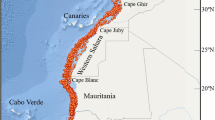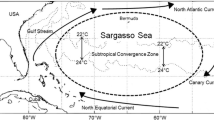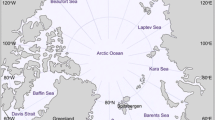Abstract
Cephalopods are sensitive to environmental conditions due to their fast growth rates and short life cycles, being thus considered good ecological indicators. Here, we analyzed western Mediterranean cephalopod paralarvae communities during two consecutive summers (2004 and 2005) characterized by contrasting oceanographic conditions. Our main aim was to determine to what extent such contrasting scenarios affected the spatial distribution of the cephalopod early life stages and decipher the main environmental factors affecting each particular taxon. The contrasting oceanographic conditions during 2004 and 2005 included differences in the shape and location of a regional frontal system, which brought about differences in the sea circulation and the temperature regime. Such contrasting scenarios were reflected in the spatial distribution and the frequencies of appearance of both the whole community and the individual taxa. There was not any major factor affecting most taxa equally, which points to differences in species sensitivity to external conditions. Moreover, our results evidenced that paralarvae populations were more influenced by regional sea salinity and temperature than by mesoscale hydrographic features. Our study reveals that moderate changes in sea temperature have a major effect on the presence of paralarvae populations, which has profound implications in the context of the current global warming.







Similar content being viewed by others
References
Alemany, F., S. Deudero, B. Morales-Nin, J. L. López-Jurado, J. L. Jansà, M. Palmer & I. Palomera, 2006. Influence of physical environmental factors on the composition and horizontal distribution of summer larval fish assemblages off Mallorca island (Balearic archipielago, western Mediterranean). Journal of Plankton Research 28: 473–487.
Alemany, F., L. Quintanilla, P. Vélez-Belchi, A. García, D. Cortés, J. M. Rodríguez, M. L. Fernández de Puelles, C. González-Pola & J. L. López-Jurado, 2010. Characterization of the spawning habitat of Atlantic bluefin tuna and related species in the Balearic Sea (western Mediterranean). Progress in Oceanography 86: 21–38.
André, J., M. Haddon & G. T. Pecl, 2010. Modelling climate-change-induced nonlinear thresholds in cephalopod population dynamics. Global Change Biology 16: 2866–2875.
Balbín, R., J. L. López-Jurado, M. Flexas, P. Reglero, C. González-Pola, J. M. Rodríguez, A. García & F. Alemany, 2013. Interannual variability of the early summer circulation around the Balearic Islands: driving factors and potential effects on the marine ecosystem. Journal of Marine Systems. doi:10.1016/j.jmarsys.2013.07.004.
Bingham, R. J. & K. Haines, 2006. Mean dynamic topography: intercomparisons and errors. Philosophical Transactions of the Royal Society of London Series A 364: 903–916.
Boyle, P. R. & P. Rhohouse, 2005. Cephalopods: Ecology and Fisheries. Blackwell Science, Oxford.
Coma, R., M. Ribes, E. Serrano, E. Jiménez, J. Salat & J. Pascual, 2009. Global warming-enhanced stratification and mass mortality events in the Mediterranean. Proceedings of the National Academy of Sciences of the United States of America 106: 6176–6181.
Danovaro, R., A. Dell’Anno, M. Fabiano, A. Pusceddu & A. Tselepides, 2001. Deep-sea ecosystem response to climate changes: the eastern Mediterranean case study. Trends in Ecology & Evolution 16: 505–510.
Danovaro, R., A. Dell’Anno, A. Pusceddu & H. Fangliang, 2004. Biodiversity response to climate change in a warm deep sea. Ecology Letters 7: 821–828.
Diekmann, R. & U. Piatkowski, 2002. Early life stages of cephalopods in the Sargasso Sea: distribution and diversity relative to hydrographic conditions. Marine Biology 141: 123–130.
Diekmann, R. & U. Piatkowski, 2004. Species composition and distribution patterns of early life stages of cephalopods at Great Meteor Seamount (subtropical North-east Atlantic). Archive of Fishery and Marine Research 51: 115–131.
Diekmann, R., Piatkowski, U. & M. Schneider, 2002. Early life and juvenile cephalopods around seamounts of the subtropical eastern North Atlantic: illustrations and a key for their identification. Berichte aus dem Institut für Meereskunde an der Christian-Aabrechts-Universität Kiel 326: 1–42.
FAO, 2012. The State of World Fisheries and Aquaculture. FAO, Rome.
González, F., J. Otero, A. Guerra, R. Prego, F. J. Rocha & A. W. Dale, 2005. Distribution of common octopus and common squid paralarvae in a wind-driven upwelling area (Ria of Vigo, northwestern Spain). Journal of Plankton Research 27: 271–277.
Keller, S., M. Valls, M. Hidalgo & A. Quetglas, 2014. Influence of environmental parameters on the life-history and population dynamics of cuttlefish Sepia officinalis in the western Mediterranean. Estuarine, Coastal and Shelf Science 145: 31–40.
Lefkaditou, E., A. Siapatis & S. Somarakis, 2005. Juvenile planktonic cephalopods sampled off the coasts of central Greece (Eastern Mediterranean) during winter. Phuket Marine Biological Center Research Bulletin 66: 259–265.
Lefkaditou, E., C. Y. Politou, A. Palialexis, J. Dokos, P. Cosmopoulos & V. D. Valavanis, 2008. Influences of environmental variability on the population structure and distribution patterns of the short-fin squid Illex coindetii (Cephalopoda: Ommastrephidae) in the Eastern Ionian Sea. Hydrobiologia 612: 71–90.
López-Jurado, J. L., J. M. García-Lafuente & N. Cano, 1995. Hydrographic conditions of the Ibiza channel during November 1990, March 1991 and July 1992. Oceanologica Acta 18: 235–243.
López-Jurado, J. L., M. Marcos & S. Monserrat, 2008. Hydrographic conditions affecting two fishing grounds of Mallorca island (western Mediterranean) during the IDEA project (2003–2004). Journal of Marine Systems 71: 303–315.
Lovegrove, T., 1966. The determination of the dry weight of plankton and the effect of various factors of the values obtained. In Barnes, H. (ed.), Some Contemporary Studies in Marine Science. Allen & Unwin, London: 429–467.
Mangold-Wirz, K., 1963. Biologie des Cephalopodes bentiques et nectoniques de la Met Catalane. Vie et Milieu 13: 285.
Morales-Nin, B., J. Moranta, C. García, M. P. Tugores, A. M. Grau, F. Riera & M. Cerdà, 2005. The recreational fishery off Majorca Island (western Mediterranean): some implications for coastal resource management. Journal of Marine Science 62: 727–739.
Moltschaniwskyj, N. A. & P. Martínez, 1998. Effect of temperature and food levels on the growth and condition of juvenile Sepia elliptica (Hoyle 1885): an experimental approach. Journal of Experimental Marine Biology and Ecology 229: 289–302.
Moreno, A., 2008. Geographic variation in cephalopod life history traits. Dissertação apresentada para accesso à categoria de Investigador Auxiliar. Unidade de Recursos Marinhos e Sustentabilidade L-IPIMA: 181.
Moreno, A., A. Santos, U. Piatkowski, A. M. P. Santos & H. Cabral, 2009. Distribution of cephalopod paralarvae in relation to the regional oceanography of the western Iberia. Journal of Plankton Research 31: 73–91.
Otero, J., X. A. Alvarez-Salgado, A. F. González, M. Gilcoto & A. Guerra, 2009. High-frequency coastal upwelling events influence Octopus vulgaris larval dynamics on the NW Iberian shelf. Marine Ecology Progress Series 386: 123–132.
Piatkowski, U., 1998. Modern target sampling techniques provides new insights into the biology of early life stages of pelagic cephalopods. Biologia Marina Mediterranea 5: 206–272.
Piatkowski, U., G. J. Pierce & M. M. Cunha, 2001. Impact of cephalopods in the food chain and their interaction with the environment and fisheries: an overview. Fisheries Research 52: 5–10.
Pinot, J. M., J. Tintoré, J. L. López-Jurado, M. L. Fernández de Puelles & J. Jansà, 1995. Three-dimensional circulation of a mesoscale eddy/front system and its biological implications. Oceanologica Acta 18: 389–400.
Pinot, J. M., J. L. López-Jurado & M. Riera, 2002. The CANALES experiment (1996–1998). Interannual, seasonal and mesoscale variability of the circulation in the Balearic channels. Progress in Oceanography 55: 335–370.
Quetglas, A., 2003. Bottom trawling cephalopod fauna from the Balearic Sea (western Mediterranean). PhD Thesis. Universitat de les Illes Balears, Spain: 184.
Quetglas, A., F. Alemany, A. Carbonell, P. Merella & P. Sánchez, 1998. Some aspects of the biology of Todarodes sagittatus (Cephalopoda: Ommastrephidae) from the Balearic Sea (western Mediterranean). Scientia Marina 62: 73–82.
Quetglas, A., A. Carbonell & P. Sánchez, 2000. Demersal continental shelf and upper slope cephalopod assemblages from the Balearic Sea (north-western Mediterranean). Biological aspects of some deep-sea species. Estuarine, Coastal and Shelf Science 50: 739–749.
Quetglas, A., F. Ordines & M. Valls, 2011. What drives seasonal fluctuations of body condition in a semelparous income breeder octopus? Acta Oecologica 37: 476–483.
Quetglas, A., F. Ordines, M. González, N. Zaragoza, S. Mallol, M. Valls & A. De Mesa, 2013a. Uncommon pelagic and deep-sea cephalopods in the Mediterranean: new data and literature review. Mediterranean Marine Science 14: 70–87.
Quetglas, A., F. Ordines, M. Hidalgo, S. Monserrat, S. Ruiz, A. Amores, J. Moranta & E. Massutí, 2013b. Synchronous combined effects of fishing and climate within a demersal community. ICES Journal Marine Science 70: 319–328.
Reglero, P., L. Cianelli, D. Alvarez-Berastegui, R. Balbín, J. L. López-Jurado & F. Alemany, 2012. Geographycally and environmentally driven spawning distributions of tuna species in the western Mediterranean Sea. Marine Ecology Progress Series 463: 273–284.
Roberts, M. J. & M. Berg, 2005. Currents along the Tsitsikamma coast, South Africa, and potential transport of squid paralarvae and ichthyoplankton. African Journal of Marine Science 27: 375–388.
Rodríguez, J. M., I. Alvarez, J. L. López-Jurado, A. García, R. Balbín, D. Alvarez-Berasategui, A. P. Torres & F. Alemany, 2013. Environmental forcing and the larval fish community associated to the Atlantic bluefin tuna spawning habitat of the Balearic region (western Mediterranean), in early summer 2005. Deep-Sea Research I 77: 11–22.
Roper, C. F. E., 1974. Vertical and seasonal distribution of pelagic cephalopods in the Mediterranean Sea: preliminary report. Bulletin of the American Malacological Union 39: 27–30.
Röpke, A., W. Nellen & U. Piatkowski, 1993. A Comparative study on the influence of the pycnocline on the vertical distribution of fish larvae and cephalopod paralarvae in 3 ecologically different areas of the Arabian Sea. Deep-Sea Research II 40: 801–819.
Roura, A., A. F. González, K. Redd & A. Guerra, 2012. Molecular prey identification in wild Octopus vulgaris paralarvae. Marine Biology 159: 1335–1345.
Sakaguchi, H., T. Hamano & A. Nakazono, 1999. Ocurrence of planktonic juveniles of Octopus vulgaris in eastern Iyo-Nada of Seto Inland Sea, Japan. Bulletin of the Japanese Society of Fisheries Oceanography 63: 181–187.
Salman, A., T. Katagan & H. A. Benli, 2003. Vertical distribution and abundance of juvenile cephalopods in the Aegean Sea. Scientia Marina 67: 167–176.
Sánchez, P., 1984. Determinación de la edad y de los parámetros del crecimiento de Illex coindetii (Verany, 1837) en el mar Catalán (Mediterráneo occidental). Investigacion Pesquera 48: 59–70.
Sánchez, P. & B. Molí, 1985. An annotated list of cephalopod larvae collected off the Mediterranean coast of Spain, 1976–1981. Vie et Milieu 35: 171–173.
Sweeney, M. J., Roper, C. F. E., Mangold, K. M., Clarke, M. R. & S. V.Boletzky (eds), 1992. “Larval” and juvenile cephalopods: a manual for their identification. Smithsonian Contributions to Zoology 513: 1–282.
Zuur, F., E. Ieno, N. Walker, A. A. Saveliev & G. M. Smith, 2009. Mixed effects models and extensions in Ecology with R. Springer, New York.
Acknowledgments
This study was financed by the BALEARES project (CTM 2009-07944 MAR) and the database was provided by the TUNIBAL project (REN 2003-01176), both competitive projects of the Spanish Government I + D+i National Plan. We want to express our gratitude to the crew of the research vessel Cornide de Saavedra and to all the scientific IEO staff that participated in the surveys and/or carried out the lab analysis.
Author information
Authors and Affiliations
Corresponding author
Additional information
Handling editor: Jonne Kotta
Rights and permissions
About this article
Cite this article
Zaragoza, N., Quetglas, A., Hidalgo, M. et al. Effects of contrasting oceanographic conditions on the spatiotemporal distribution of Mediterranean cephalopod paralarvae. Hydrobiologia 749, 1–14 (2015). https://doi.org/10.1007/s10750-014-2132-x
Received:
Revised:
Accepted:
Published:
Issue Date:
DOI: https://doi.org/10.1007/s10750-014-2132-x




